REPORT ON ‘TRADE POLICY TOOLS FOR CLIMATE ACTION’
- Report titled ‘Trade Policy Tools for Climate Action’ released by World Trade Organization (WTO).
- It covers ten trade policy areas that governments could consider as part of their strategies to promote sustainability and support UNFCCC-COP28’s climate mitigation efforts.
Major Trade Policy Tools | Actions |
Trade facilitation | Speed up customs clearance, reducing Greenhouse Gas (GHG) emissions associated with inefficient customs procedures, etc. |
Regulations and certification | Use international standards to avoid regulatory fragmentation when upgrading energy efficiency regulations. |
Import tariffs | Accelerate transition to green economy by rebalancing tariff policies that may inadvertently benefit carbon-intensive sectors |
Subsidies | Unlock additional resources to assist climate action by reforming environmentally harmful support measures. |
Sanitary and phytosanitary measures | Protect economies from spread of disease and pests exacerbated by climate change by strengthening sanitary and phytosanitary systems. |
Internal taxation and carbon pricing | Reduce policy fragmentation and compliance costs by improving coordination of climate-related issues etc. |
- Impact of Trade on Climate
- About 20-30 percent of total CO2 emissions, which account for most GHG emissions, are estimated to be associated with international trade.
- Sectors including energy and transportation account for more than 75 percent of GHG emissions embedded in international trade.
- Accelerate use of natural resources which in turn can increase pressure on ecosystems.
- Environmental damage e.g. Rise in palm oil demand led to clearing of rainforest in Indonesia.
- About 20-30 percent of total CO2 emissions, which account for most GHG emissions, are estimated to be associated with international trade.
- Tags :
- Trade Policy
- Climate Action
- trade and climate
ENVIRONMENTAL IMPACT ASSESSMENT (EIA)
- Supreme Court Stays MoEF&CC's office memorandum on ex-post facto environmental clearance.
- Stay is imposed on orders issued by Ministry of Environment, Forest and Climate Change (MoEF&CC) in 2021 and 2022 for ex-post facto clearance for mining projects.
- Such ex-post facto clearance provides projects to carry out operations without getting environmental clearances.
- Earlier, prior environmental clearance was mandated under Environmental Impact Assessment (EIA) notification of 2006.
- However, in 2017, government provided a six-month window for alleged violators to apply for post facto clearances. This was stayed by the Madras HC.
- In 2021, ministry issued standard operating procedures for processing EIA applications allowing ex facto environment clearance.
- About EIA
- It is defined as a tool used to identify environmental, social and economic impacts of a project prior to decision-making.
- Under Environment (Protection) Act, 1986, India notified its first EIA norms in 1994, and subsequent amendments were made.
- EIA aimed at imposing certain restrictions and prohibitions on new projects, or on expansion of existing projects etc. based on their potential environmental impacts, unless prior environmental clearance has been accorded.
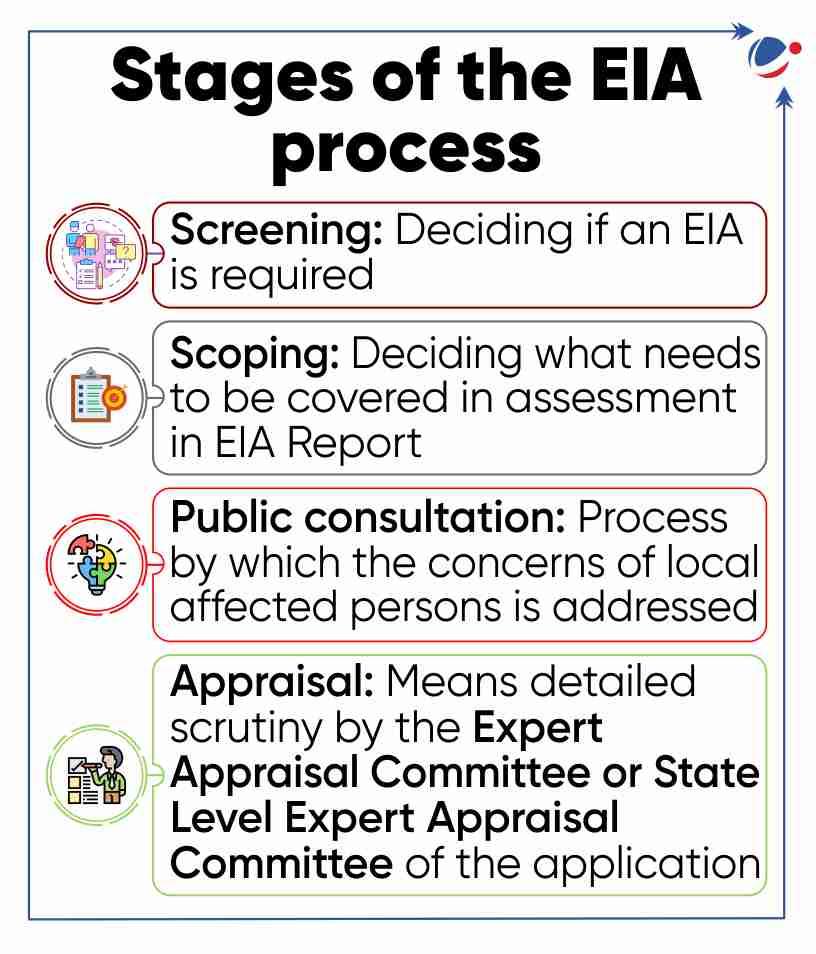
- Tags :
- EIA
- Sustainable Development
- environmental clearance
MEGALOSAURUS
- 2024 marks the bicentennial (200th year) of the first scientific naming of a dinosaur, the megalosaurus (meaning great lizard).
- These carnivorous dinosaur’s fossils were discovered in Oxfordshire, England (UK).
- In 1824, they were named based on scattered bones, including vertebrae, and hip.
- Dinosaurs are a diverse group of reptiles of the clade Dinosauria.
- They belong to the Mesozoic Era ((252-66 million years ago) which includes three consecutive geologic periods (Triassic, Jurassic, and Cretaceous).
- They are believed to be ancestors of modern Birds.
- Tags :
- Dinosaurs
LATITUDINAL DIVERSITY GRADIENT (LDG)
- A recent study examined role of major classes of Mycorrhizal Fungi - arbuscular mycorrhizal and ectomycorrhizal in LDG.
- LDG refers to the pattern of having lots of species at the equator with diversity reducing towards poles.
- Study found that:
- Mycorrhizal fungi form mutually beneficial relationships with majority of plant roots globally.
- Arbuscular fungi, common near equator promote diversity.
- Ectomycorrhizal fungi, common at higher latitudes support single tree species, reducing diversity.
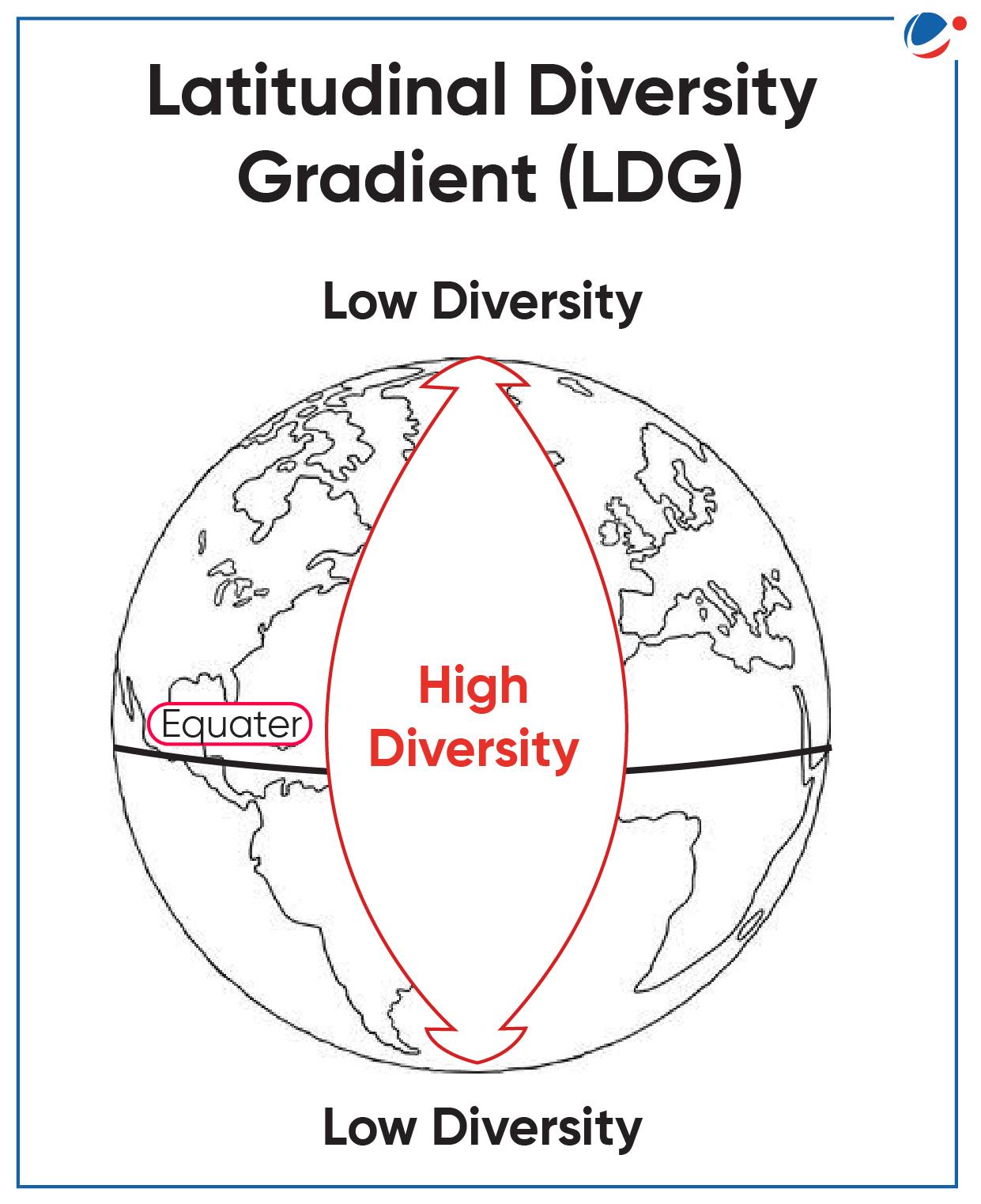
- Tags :
- Geography
- Fungi
GREEN FUELS ALLIANCE INDIA (GFAI)
- Denmark announces Green Fuels Alliance India (GFAI) initiative.
- It is part of Green Strategic Partnership (GSP) signed in 2020 between India and Denmark.
- Its primary objective is to promote sustainable energy growth in India by encouraging collaboration among businesses, government entities, research institutions, etc. from both countries.
- It is inspired by initiatives like India-Denmark Energy Partnership, and joint R&D efforts on Green Fuels, etc.
- Goals and significance
- Strengthen collaboration in sustainable energy solutions.
- Advance joint goals towards carbon neutrality.
- Enables renewable energy production in India towards ambition to be global leader in green energy value chain.
- Help in accelerating net zero emissions by 2070.
- Foster innovation, collaboration, and partnerships among firms, businesses, and government.
- Green fuels, also called green hydrocarbons, biofuels, are fuel produced from biomass sources through variety of biological and thermochemical processes.
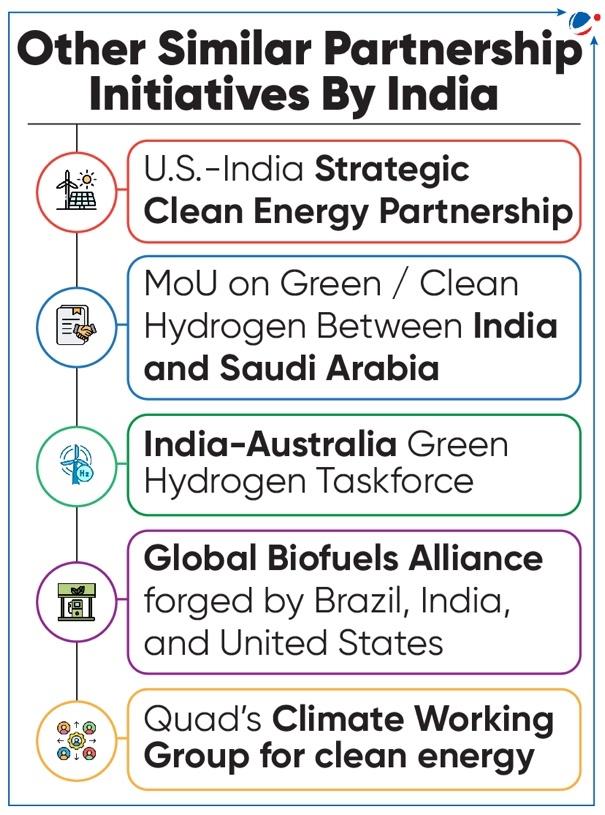
- Tags :
- Renewable Energy
- Green Fuels
- Denmark
- Green partnership
5 YEARS OF NATIONAL CLEAN AIR PROGRAMME (NCAP)
- Ministry of Environment, Forest and Climate Change (MoEFCC) launched NCAP in 2019 in the backdrop of the rising air pollution in the country.
- About NCAP:
- About: Aims to improve air quality in 131 cities (non-attainment cities (NAC) and Million Plus Cities) in 24 States by engaging all stakeholders.
- The cities which are exceeding the National Ambient Air Quality Standards (NAAQS) for 5 consecutive years are identified as NAC by Central Pollution Control Board (CPCB).
- Target: To achieve reductions up to 40% of Particulate Matter (PM10 and PM2.5) concentrations by 2025-26, base year 2017.
- Implementation: CPCB at the national level.
- Under it, City Action Plan’s (CAPs) are implemented by state government and its agencies at state and city level (Municipal bodies).
- PRANA (Portal for Regulation of Air-pollution in NAC) has been also launched monitor the implementation of NCAP.
- About: Aims to improve air quality in 131 cities (non-attainment cities (NAC) and Million Plus Cities) in 24 States by engaging all stakeholders.
- NCAP's progress in last 5 years reveals a mixed scenario.
- As per studies, PM2.5 in 27 cities recorded improvements out of 49 cities.
- Similarly, for PM10, 24 cities saw an improvement out of 46.
- In terms of cities, Varanasi achieved a significant reduction in PM2.5 and PM10 levels, along with Agra and Jodhpur.
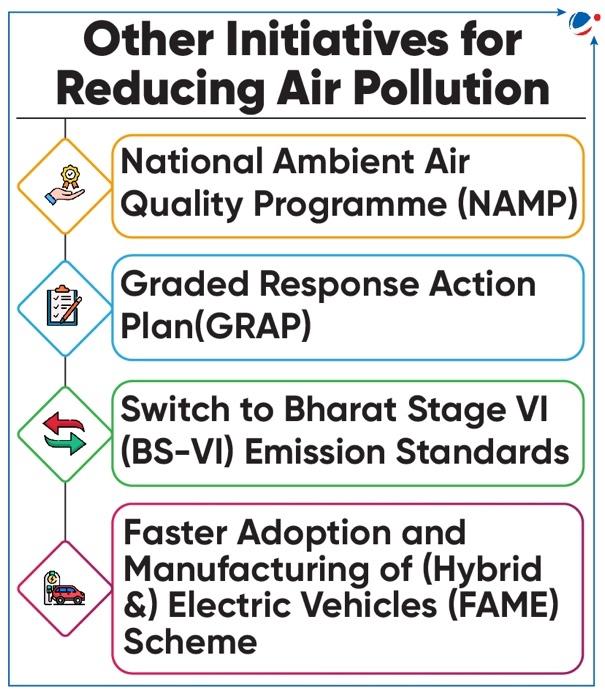
- Tags :
- Air Pollution
- city action plan
- air quality
GLOBAL RISK REPORT 2024
- Report is based on Global Risks Perception Survey and annually released by World Economic Forum.
- Key findings
- India’s top five risks: Misinformation and Disinformation (MI); Infectious diseases; Illicit economic activity; Inequality (wealth and income); and Labour shortage.
- Global short-term risks: MI; Extreme Weather Events (EWS); Societal polarization; Cyber insecurity; etc.
- Global long-term risks: EWS; Critical change to Earth systems; Biodiversity loss and ecosystem collapse etc.
- Tags :
- World Economic Forum (WEF)
- Global Risk Perception Survey
GLOBAL OCEAN HEAT CONTENT (OHC)
- In 2023, Global Ocean Heat Content (OHC) doubled or tripled since the late 1980s, shows study.
- Key Findings:
- Amount of heat stored in the upper 2,000 metres of the global ocean reached 286 Zetajoules (ZJ) in 2023 relative to the 1981–2010 average.
- 2023 estimate of ocean heat content (OHC) represents around 4.6 billion Hiroshima nuclear bombs.
- As Oceans absorb 90% of heat from global warming, the Atlantic, North and Western Pacific, and Southern Oceans are warming at a faster rate than the global average.
- About OHC:
- It is defined as the total amount of heat absorbed by and stored in the oceans and measurements of water temperature reflect the amount of heat in the water at a particular time and location.
- It is measured in Joules, the unit of energy.
- Water has a higher heat capacity than air, which means that it can store much larger amounts of heat.
- Role of Ocean Heat Content:
- Affects Earth's energy, water, and carbon cycles.
- Important indicator of Climate change.
- When the ocean warms, it releases heat and moisture into the atmosphere intensifying storms, causing severe weather events.
- Lowering the level of oxygen in the water.
- Rising ocean temperatures directly affect Corals.
- Tags :
- Oceans
- Global Warming
CONJOINED SILVERLINE (CIGARITIS CONJUNCTA)
- It is a new butterfly species identified in Karnataka’s Kodagu district.
- It is first such find in Western ghats in last 4 decades.
- It consists of fused spots and bands on underside of wings, and shiny silver lines in centre of those bands.
- While males have “dark shining blue” wings, females have “dark brown” wings.
- Lower tips of their wings have a pattern of orange dots that look like “false head” to protect them from predatory attacks.
- Tags :
- Wildlife Conservation
- Butterfly
HUMBOLDT’S ENIGMA
- It was proposed by Alexander von Humboldt stating that mountain regions generally display higher diversity than tropical regions.
- While the conventional belief is that the world’s tropical areas have greater productivity and diversity.
- The proponents of Humboldt’s enigma hold that many areas outside the tropics are also highly biodiverse. i.e., the Mountains
- Supporting this, scientists have also found that the more heterogeneous the geological composition of mountains is, the more biodiverse they are.
- Tags :
- Biodiversity
HIMALAYAN WOLF
- First-ever IUCN assessment of the Himalayan Wolf published.
- Major Findings:
- Declining Population: IUCN’s assessment has flagged a ‘continuing decline in area, extent and/or quality of habitat’ of Himalayan wolves.
- Estimated total population of 2,275–3,792 (227–378 in India) mature individuals.
- Major threats
- Depredation Conflict: Due to Habitat modification and encroachment and depletion of wild prey populations.
- Hybridization with Dogs: Especially in Ladakh and Spiti where populations of feral dogs are increasing.
- Illegal Hunting: For trade in its fur and body parts including paws, tongues, heads, etc.
- About Himalayan Wolf (Canis lupus ssp. chanco)
- Habitation: High altitude (above 3,900m) in the Himalayas (Nepal and India) and the Tibetan Plateau.
- Possess genetic adaptations to cope with hypoxic conditions.
- Characteristics: Thick fur with brown coloration on the back and tail with paler yellows on the face, limbs, and underside.
- Larger than the Indian and European wolves.
- Prefer wild over domestic prey.
- Conservation Status
- IUCN’s Red List: Vulnerable
- Wildlife Protection Act, 1972: Schedule I
- CITES: Appendix I
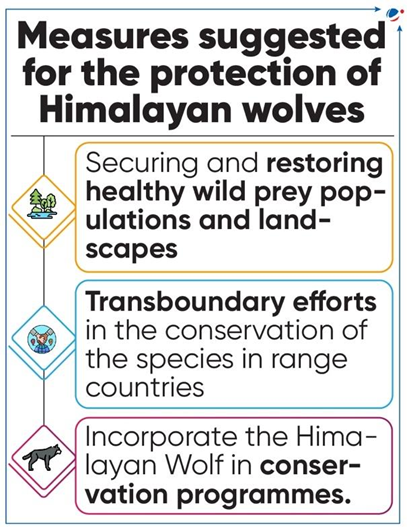
- Tags :
- Wildlife
- Schedule I WPA
- Vulnerable
- Appendix I CITES
TIBETAN BROWN BEAR
- India has recorded its first-ever confirmed sighting of a rare Tibetan brown bear (Ursus arctos pruinosus) in Sikkim.
- About Tibetan Brown Bear
- It is also known as the Tibetan blue bear.
- It is an omnivore (eat and survive on both plant and animal matter)
- Feature: Has a distinctive ‘V’ shaped white chest mark
- Habitat: Inhabits alpine forests, meadows, and steppe, at elevations from 2,000 to 4,500 metres.
- Mainly found in Nepal, Bhutan and the Tibetan plateau.
- Status:
- Wildlife Protection Act, 1972 (Schedule 1)
- CITES (Appendix 1)
- Tags :
- Wildlife
- Schedule I WPA
- Appendix I CITES
KUMKI ELEPHANTS
- The Odisha government requested the deployment of kumki elephants from Tamil Nadu to address escalating human-elephant conflicts.
- Kumkis, trained captive elephants, excel in trapping, rescuing, and tranquilizing wild elephants.
- Their strategic deployment aims to mitigate damage to crops, human settlements, and minimize the risk to both human and elephant lives.
- Additionally, kumki elephants prove valuable for forest patrolling and rescue operations.
- Tamil Nadu has used Kumkis successfully.
- Tags :
- Wildlife
- Elephants
VULTURE RESTAURANT
- Vulture restaurant set up in Jharkhand to conserve Critically Endangered species.
- A ‘Vulture Restaurant’ has been established in Koderma district, Jharkhand to address adverse impact of livestock drugs, particularly diclofenac, on vultures.
- Vulture restaurant is an undisturbed area where non-toxic, poison-free meat and carcasses are provided for vultures and other scavengers.
- There are other such restaurants in Raigad, Gadhchiroli and Nashik district in Maharashtra and Kangra district in Himachal Pradesh.
- Diclofenac is Non-steroidal Anti-Inflammatory drugs, used in veterinary practice that has been proven toxic to vultures and other birds of prey.
- Vulture restaurant is an undisturbed area where non-toxic, poison-free meat and carcasses are provided for vultures and other scavengers.
- Vultures are large carrion-eating birds found mainly in tropics and subtropics.
- 9 species of vultures are found in India. Out of them, 3 species are migratory (Cinereous vulture, Griffon vulture and Himalayan vulture).
- They maintain clean environment by acting as nature's garbage collectors and control spread of wildlife diseases from rotting corpse.
- Conservation status: Protected under Schedule (1) of Wildlife Protection Act 1972.
- Threats: Loss of natural habitats due to human activities, Food scarcity, Population decline due to exposure to drug diclofenac, Electrocution by power lines etc.
- Vulture Conservation Initiatives
- Ban on Veterinary use of Diclofenac (2006), Ketoprofen and Aceclofenac (2023).
- Action Plan for Vulture Conservation in India 2020-25.
- Vulture Conservation Breeding Centre in Pinjore, Haryana.
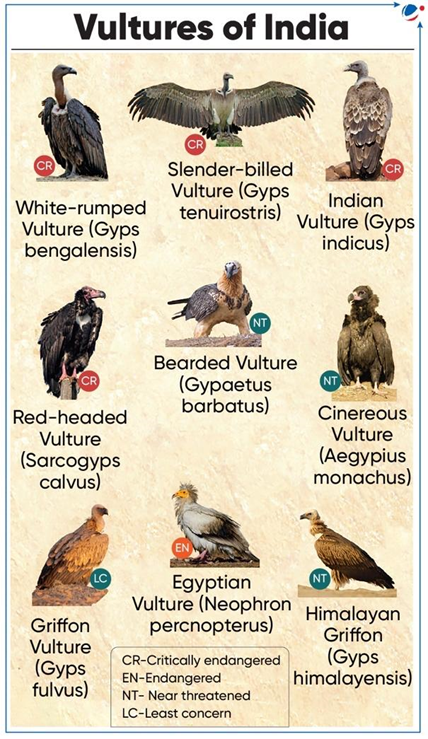
- Tags :
- Wildlife Conservation
- Vulture
- Schedule I WPA
- critically endangered
- endangered
EURASIAN OTTER
- Recently, Eurasian otter was found in the Chinnar Wildlife Sanctuary in Kerala.
- About Eurasian otter (Lutra lutra):
- Features: Shy, nocturnal, good swimmer and fish catcher etc.
- Habitat: Semi-aquatic, lives in water bodies, marshes, swamp forests, coastal areas etc.
- Distribution:
- World: Europe, Asia and Africa.
- India: Northern, northeast and southern India.
- Conservation Status:
- IUCN List: Nearly Threatened
- Wildlife Protection Act: Schedule I
- CITES: Appendix I
- Threats: Pollution, poaching, habitat loss, accidental trapping etc.
- Tags :
- Wildlife
- otter
- Schedule I WPA
- Appendix I CITES
BINTURONG (ARCTICTIS BINTURONG) AND SMALL-CLAWED OTTER (AONYX CINEREUS)
- These two new mammalian species were added to list of fauna in Assam’s Kaziranga National Park.
- Both are listed under Schedule I of Wildlife Protection Act 1972.
- Binturong (Bearcat) largest civet in India.
- Native: South-East Asia.
- Distribution: India (Meghalaya, Sikkim), Indonesia, Thailand, Malaysia, etc.
- Conservation: Vulnerable (IUCN); Appendix III (CITES).
- Small-clawed otter (Asian Small-clawed Otter) primarily found in freshwater habitats.
- Distribution: India (West Bengal, Assam, Arunachal Pradesh, Karnataka, Tamil Nadu, and Kerala), Southeast Asia and Southern China.
- Conservation: Vulnerable (IUCN); Appendix I (CITES).
- Tags :
- Wildlife
- otter
- Schedule I WPA
- Vulnerable
- Appendix I CITES
INVASIVE MOSQUITOFISH SPECIES
- These two species of mosquitofish are Gambusia affinis and Gambusia holbrooki. Both are detrimental Invasive Alien Species.
- Mosquitofish was introduced into local water bodies to address mosquito menace by states like Andhra Pradesh, Odisha and Punjab.
- Their feeding habits and aggressive behavior in habitats have led to extinction ofendemic species.
- Invasive Alien Species (IAS) are animals, plants or other organisms that are introduced from outside their natural range, negatively impacting native biodiversity, ecosystem services or human well-being. Example, Water hyacinth, Lantana, etc.
- Globalization through increasing trade, transport, travel and tourism increases introductions of invasive species to new areas.
- Impact of Invasive Alien Species
- Economic Impact: Global economic cost of IAS exceeded $423 billion annually in 2019.
- Food Security: Invasive species are major cause of crop loss and degraded soil quality.
- Ecological Impact: 1 in 10 species on IUCN Red List are threatened by IAS.
- Heath Impact: They can serve as vectors for infectious diseases. Example, Malaria, West Nile Fever etc.
- Efforts taken to control Invasive Species
- Target 6 of Kunming-Montreal Global Biodiversity Framework eliminates IAS impacts on biodiversity by 2030.
- Global Invasive Species Programme, 1997.
- Ramsar Convention.
About Gambusia
|
- Tags :
- Invasive Alien Species (IAS)
KURIL ISLANDS
- Earthquake of magnitude 6.3 on the Richter scale occurred in Kuril Islands.
- Kuril Islands is an archipelago that extends from Kamchatka Peninsula (Russia) to Hokkaido Island (Japan).
- It separates the Sea of Okhotsk from Pacific Ocean.
- Many of its islands are geologically active.
- Russia and Japan both assert sovereignty over four islands (referred to as the Northern Territories in Japan and South Kurils in Russia).
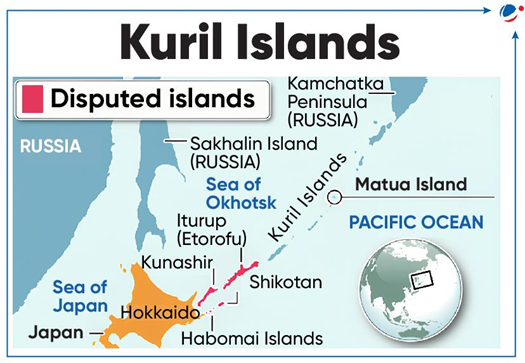
- Tags :
- Islands
- Earthquake
- Disputed Islands
- kuril
WILLINGDON ISLAND
- The demand has been raised to revive Willingdon Island, which took on a deserted appearance following the relocation of container terminal operations to Vallarpadam (Kerala).
- Willingdon Island
- It is one of the largest man-made islands in the country, located near Kochi.
- The island was created in 1933 and named after the then British Viceroy of India, Lord Willingdon.
- The island was created with soil trench produced during the deepening of the famous Vembanad Lake for the construction of the modern Kochi Port.
- Tags :
- Islands
- willingdon
DEEP-SEA CORAL REEF
- Scientists mapped largest deep-sea coral reef off the US Atlantic coast
- Underwater mapping technology enables to construct 3D images of ocean floor, facilitating the mapping of coral reef at depth 200 meters to 1,000 meters where sunlight doesn't penetrate.
- More of ocean floor is covered by deep-sea reefs than by tropical reefs, which are found at 0-30 meters depth with light penetration.
- Great Barrier Reef in Australia is the biggest tropical coral reef system in world.
- More of ocean floor is covered by deep-sea reefs than by tropical reefs, which are found at 0-30 meters depth with light penetration.
- Deep-sea corals are colonies of small animals that build a common skeleton, which grows into many shapes and colors. They provide habitat for sharks, swordfish, shrimp, fish etc.
- Corals are invertebrate animals belonging to a large group of colourful animals called Cnidaria.
- Coral reefs are made up of colonies of hundreds to thousands of tiny individual corals, called polyps.
- These marine animals have hard exoskeletons made of calcium carbonate.
- In India, Coral reefs are found in Gulf of Kutch, Gulf of Mannar, Andaman & Nicobar, Lakshadweep Islands and Malvan (Maharashtra).
- Importance of Corals: Protect coastlines from storms and erosion; Provide jobs for local communities; Offer opportunities for recreation etc.
- Threats to Corals: Disturbance from oil and gas drilling, Ocean acidification, Unsustainable fishing, Coral harvesting etc.
Difference between Deep Sea Corals and Shallow Water Corals
Specifications | Deep Sea Coral | Shallow-water corals |
Diversity of corals | Rely either by feeding on organic material falling from surface or by feeding on small plankton | Rely on photosynthetic algae (tiny single-celled plants, known as zooxanthellae) that live within corals and provide their hosts with nutrition |
Appearance | White in coloration | Brown and green colors due to algae |
Structure formed | Groves in form of tree, feather, column, or fan shapes, etc. | Rock-like reefs |
- Tags :
- Coral Reef
WILDLIFE (PROTECTION) LICENSING (ADDITIONAL MATTERS FOR CONSIDERATION) RULES, 2024
- Ministry of Environment Forest and Climate Change (MoEFCC) notified Wildlife (Protection) Licensing (Additional Matters for Consideration) Rules, 2024.
- These rules aim to replace Wildlife (Protection) Licensing (Additional Matters for Consideration) Rules, 1983.
- 1983 rules prohibited issuing licences to trade in a wild animal categorised under Schedule I or Part II of Schedule II under Wildlife Protection Act (WPA) 1972.
- Licences were granted in exceptional cases with previous approval of central government.
- This condition has been changed in 2024 rules.
- New 2024 rules
- No such licence shall be granted if it relates to any wild animal specified in Schedule I to the Act, except with previous consultation of Central Government.
- Chief Wildlife Warden or an Authorised Officer issues the licence based on parameters like existing licences and implications of licence on hunting or trade of wild animals concerned etc.
- Impact of New Rules: Might adversely affect mammals and birds enlisted in Schedule II, as some of them are already endangered. Examples: Bulbuls, Falcons, Turtles, Geckos, Snakes, Bats etc.
- Earlier, Wildlife Protection (Amendment) Act, 2022 has reduced the number of Schedules from 6 (as of 1972 act) to 4. (Refer Table).
Schedule I | Animal species with highest level of protection. Example: Blackbuck, Sloth Bear, Cheetah, Swamp Deer etc. |
Schedule II | Animals with lesser levels of protection. Example: Nilgai, Indian Flying fox, Andaman Bulbul etc. |
Schedule III | Protected Plant species. Example: Neel Kurinji, Pitcher plant, Tree turmeric etc. |
Schedule IV | Specimens listed in Appendices under Convention on International Trade in Endangered Species of Wild Fauna and Flora (CITES). Example: River Dolphin, Spider Monkeys, etc. |
- Tags :
- Wildlife Conservation
- Wildlife Rules
- WPA
- Schedules WPA
WADGE BANK ECOSYSTEM
- Wadge Bank Ecosystem may be impacted by proposed exploration and development of oil and gas blocks.
- These blocks will be explored under the Hydrocarbon Exploration and Licensing Policy (HELP).
- About Wadge Bank Ecosystem
- It lies south of Cape Comorin in the Kanyakumari district in Tamil Nadu.
- It is part of Indian continental shelf.
- It is one of the most productive coastal areas in the world.
- In this region, seas (Bay of Bengal and Arabian Sea) meet with a distinct pattern of water currents in different seasons (southwest and northeast monsoon).
- Tags :
- Oil
- Gas
- HELP
KUNO NATIONAL PARK (KNP)
- Recently, a Namibian cheetah translocated to KNP under Project Cheetah, gave birth to 4 cubs.
- About Kuno National Park
- Location: In Madhya Pradesh and is a part of Central Indian Vindhyan Hills.
- Forest: Dry Deciduous.
- River: Kuno river is main source of water.
- Flora: Mainly dominated by Kardhai, Salai, Khair trees, along with vast grasslands.
- Fauna: Spotted deer, Chousingha, Nilgai, Black buck, Leopard, Wild dog or Dhole, etc.
- Tags :
- National Park
- Environment Protection
- Cheetah



